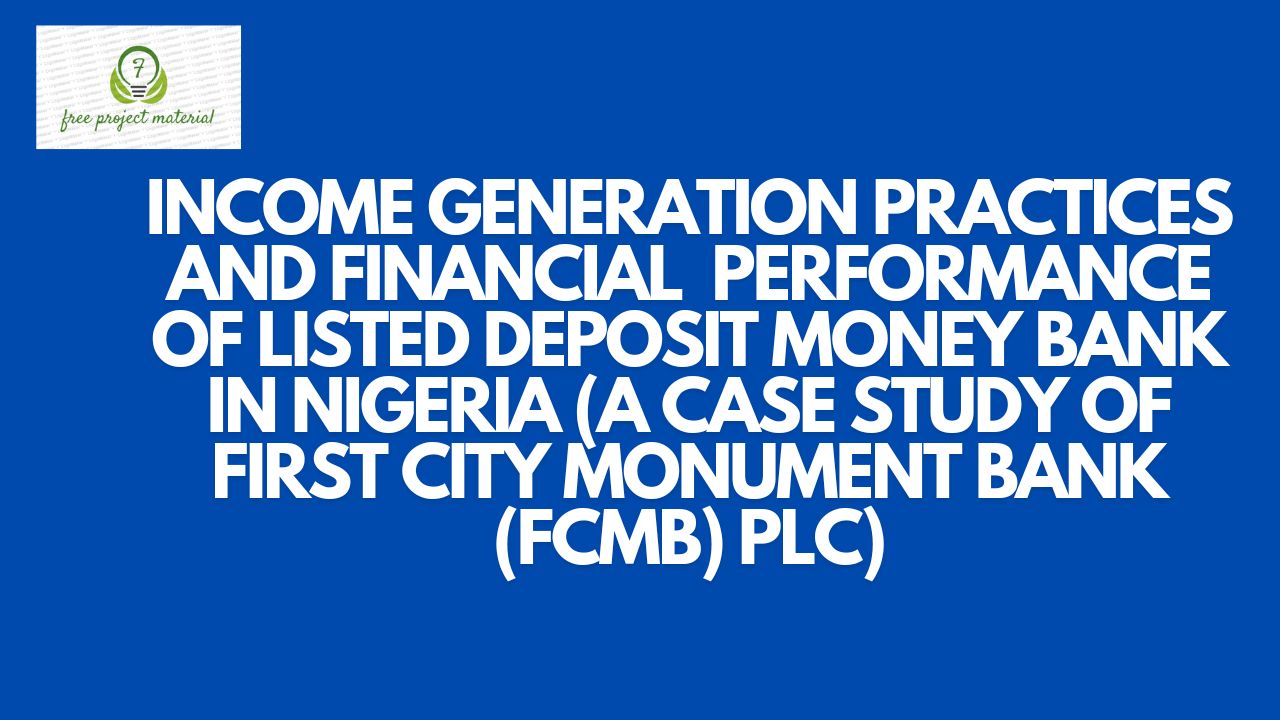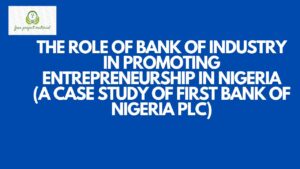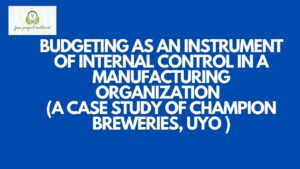ABSTRACT
This research work is on income generation attributes and financial performance of listed deposit money banks in Nigeria was aim at evaluating the influence of income generation on financial performance in terms of profit for the year and net Asset. Primary and secondary method of data collection was use in gathering relevant data for this research work. The primary data adopted was questionnaire while the secondary was First City Monument Bank (FCMB) Plc. Statement of Account Budgeted and actual expenditure from 2010-2019. The secondary was the respect of the independent and dependent variable and a quota control sampling drawn from a non-profitability sampling technique was used in carrying out this research work. The researcher adopted survey research design which was descriptive and explanatory in nature. The statistical data use was simple linear regression H0 was accepted which states that there is no significant impact of internally generated revenue on health infrastructural development in Akwa Ibom State. A total of 20 questionnaire was administered, 18 was fully completed and returned. Findings from the study revealed that the impact of Internally generated revenue on health infrastructural development include: Assist in provision of sufficient revenue for infrastructures, providing of sufficient revenue for infrastructures, providing adequate basic infrastructures, reducing over-dependence on external sources and etc. The study recommended that the state government should hands off revenue generating profit belonging to local government back to them, also local councils should being to invest in real productive ventures as this is likely to improve their revenue.
TABLE OF CONTENTS
Cover page – – – – – – – – – i
Fly leaf
Declaration – – – – – – – – – ii
Certification – – – – – – – – – iii
Dedication – – – – – – – – – iv
Acknowledgment – – – – – – – – v
Abstract – – – – – – – – – vi
Table of contents – – – – – – – – vii
List of table – – – – – – – – – ix
CHAPTER ONE
INTRODUCTION
1.1 Background of the study – – – – – – 1
1.2 Statement of the problem – – – – – – 5
1.3 Objective of the study – – – – – – 6
1.4 Research Questions – – – – – – – 6
1.5 Research Hypothesis – – – – – – – 7
1.6 Significance of the study – – – – – – 7
1.7 Scope and Limitations of the study – – – – – 8
1.8 Organization of the study – – – – – – 8
1.9 Operational Definition of key terms – – – – – 8
CHAPTER TWO
REVIEW OF RELATED LITERATURE
2.1 CONCEPTUAL REVIEW – – – – – – 10
2.1.1 Concept and Meaning of income Generation and Earnings Management – 10
2.1.2 Income Generation Objects – – – – – – 12
2.1.3 Dimension of Generation – – – – – – 13
2.1.4 Reasons for managers manipulation of income for the firm – – 14
2.1.5 Reasons for manipulation of income against the firm by managers – 15
2.1.6 The need for income generation – – – – – 15
2.1.7 Methods of income generation – – – – – 16
2.1.8 Factors Affecting income Generation practice – – – 19
2.1.9 Remedies to the challenge of income Generation practice in Nigeria – 21
2.1.10 Relationship Between income Generation practice and
Profitability in Banks – – – – – – – 22
2.1.11 Effects of International Financial Reporting Standards
(IFRS) on income Generation practice – – – – 23
2.2 THEORETICAL REVIEW – – – – – – 24
2.2.1 Agency Theory – – – – – – – 24
2.2.2 Accounting Theory – – – – – – – 25
2.2.3 Contracting theory – – – – – – – 26
2.2.4 Earnings Quality – – – – – – – 31
2.3 Empirical Review – – – – – – – 37
2.4 Summary of Related Literature – – – – – 39
2.5 Research Gap – – – – – – – – 40
CHAPTER THREE
METHOLOGY
3.1 Research Design – – – – – – – 41
3.2 Area of the study – – – – – – – 41
3.3 Population of the study – – – – – – 41
3.4 Sample and Sampling Techniques – – – – – 41
3.5 Source and Nature of Data – – – – – – 42
3.6 Instrument/ Method of Data collection – – – – 42
3.7 Method of Data Analysis – – – – – – 42
3.8 Theoretical specification of model – – – – – 43
3.9 Empirical specification of model – – – – – 43
3.10 Ethical issues – – – – – – – – 44
CHAPTER FOUR
DATA PRESENTATION, ANALYSIS AND DISCUSSION OF FINDINGS
4.1 Presentation of Data – – – – – – – 45
4.2 Analysis of Data – – – – – – – 51
4.2.1 Analysis of Research Questions – – – – – 51
4.2.2 Test of Hypothesis (es) – – – – – – 56
4.3 Discussion of Findings – – – – – – 60
CHAPTER FIVE
SUMMARY, CONCLUSION AND RECOMMENDATIONS
5.1 Summary of Findings – – – – – – – 61
5.2 Conclusion – – – – – – – – 62
5.3 Recommendations – – – – – – – 62
5.4 Implication of Findings – – – – – – 62
5.5 Contribution to knowledge – – – – – – 63
5.6 Suggestion for further study – – – – – – 63
References
Appendices
LIST OF TABLES
Table 4.1.1: Questionnaire Administration/Response – – – 45
Table 4.1.2: Respondents by Gender – – – – – 46
Table 4.1.3: Respondents by Marital Status – – – – 46
Table 4.1.4: Respondents by Age Group – – – – – 47
Table 4.1.5: Respondents by Year of Service – – – – 47
Table 4.1.6: Respondents BY Professional – – – – 48
Table 4.1.7: Respondents by Department – – – – – 49
Table 4.1.8: First City Monument Bank Plc for the Year and Net Asset – 50
Table 4.2.1.1: Response to Research Question One – – – – – 51
Table 4.2.1.2: Response to Research Question Two – – – – – 52
Table 4.2.1.3: Response to Research Question Three – – – – 53
Table 4.2.1.4: Response to Research Question Four – – – – – 54
Table 4.2.1.5: Response to Research Question Five – – – – – 55
Table 4.2.2: The relationship between profit for the year and Net Asset – 56
CHAPTER ONE
INTRODUCTION
1.1 BACKGROUND OF THE STUDY
Financial statement are the medium used by management to show the reward of their stewardship towards the resources entrusted to them. The statement are prepared to convey information researching the financial position, performance and cash flow of firm. Since stakeholders have no access to firms accounting records they depend heavily on such financial statement when making any judgment and decision. Consequently managers tend to report favorable accounting figures in their financial statement, which may influence the decision made.
In the development of the banking sector today various attempts have been made in obtaining public funds. Among others, is through the capital market. The financial report is a tool information used that is used for investors to harvest their funds. The part of the financial statement that got the attention of stakeholders is profit, because profit is vital for the company. Profit can be used to access performance for the company (Gideon, 2011). the company management performs earnings management since profit is one for the information in the financial statement used to determine manager compensation.
One of the purpose of financial reporting in providing information about financial position and about the performance of firms to stakeholders like shareholders, investors, government and other parties, this information is mainly relevant for the economic decision in the stakeholders. When a firm in a year realized low earnings, the management of the firm may use of the most practice methods to make financial statement Look rosy by inflating and deflating the positions of profitability. Earnings management is characterized by the concept or profitability. Earning management uses the flexibility created by the accounting regulations to manipulate earnings within the opportunities that are offered by the accounting standards.
This results in the situation that the management does not report the actual earning that have been occurred in a certain period. According to critics, shareholders and other external parties are misled by the management is ethically justified. Nevertheless, also advantages exist when using earnings management. This is because of the formativeness of the reporting of current and past earnings that will provide information about the future earnings. Therefore, the users of financial information will base their decision on the future information, this is particularly important for investors when investors have sufficient trustful information, it will be more attractive to make investment in the firm.
Different ways exists to manipulate earnings income generation is a particular form of earning management. Ronen and Saden, (2011) opined that income generation means depending the fluctuation in the series of reported earning by inflating low earnings and deflating high earnings. To realize generation earning and in good time will prefer low earnings. An active incentive to generate incomes that managers have the vision that of the earnings are steadily growing, the investors will expect that this growth will be continued, this will make the investors have more confidence in the firm.
Income generation is often criticized in that it does not give a representative view about the actual pattern that earning follow during a certain period. Income generation becomes dangerous when the unit of transferring earning has been reached and the whole thing collapses. Consequences are that shareholders will be seriously financially harmed. Critics mostly emphasize these point when reviewing income generation.
However, against the negative view about income generation, there is one important arguments in favour of income generation, “Informativeness” Zarowin (2013) Opined that more generation aid stock price informativeness, where the amount of information about future earnings or future cash flow reflected is the current period stock return in order words, it is the ability of investors to abstract information about future earnings out of current stock returns. When deposit money banks report their earnings which is general will be more volatile, it is more difficult for shareholders to determine future performance especially on the short-term and when incomes are generated, it is better to be able to use short-term expectation for long term performance of the banks. Against this background, it is necessary to examine income generation practice and financial performance of listed deposit money bank in Nigeria, a case study of FCMB Plc.
INTRODUCTION OF FCMB PLC (THE HISTORY)
The entity from which the bank was founded City Securities Limited (CSL) was established in 1977 by Oloye Suboni Balogun, the Otumba Tunwashe of Ijebu, a Yoruba Traditional aristocrat.
In 1982 First City Merchant Bank was established with seed capital from CSL. It was incorporated as a private limited liability company on 20 April 1982 and granted a banking license on 11 August 1983. It was the first bank to be established in Nigeria without government or foreign support. The bank was a clear leader in investment banking and increasing attracts and develops highly skilled staff in 1990, in 1996 the bank was the first and at that time the largest loan syndication of N70 for the National Fertilizer Company of Nigeria (Now NOTORE) is a Landmark achievement in 1996. In 2001, the name of the bank was changed from First City Merchant Bank to First City Monument Bank Limited following the bank’s transformation to a universe bank. A subsidiary FCMB capital markets limited, was formed to support its corporate finance activities on 15 July, 2004, FCMB changed its status from a private Limited Liability Company to a public Limited Liability Company and was listed on the Nigeria Stock Exchange (NSE) by introduction on 21 December 2004. In 2007 credit Direct Limited, a non- bank subsidiary was established.
As a result of the 2010 Central Bank of Nigeria (CBN) regulation, FCMB Group Plc was formed and become the financial holding company for FCMB’s direct subsidiary. In 2012 FCMB completed the acquisition of pin bank plc in February 2012 and subsequently merged with fin bank in October 2012.
In June 2013, FCMB assumed a holding structure in accordance with the regulations set by the central bank of Nigeria.
In 2014, FCMB (UK) Limited a branch of First City Monument Bank Limited, was authorized to operate in the United Kingdom. It is regulated by the financial conduct Authority and the potential Regulation Authority. In November 2017, FCMB Group acquired FCMB pensions Limited (Formerly Legacy pensions managers Limited). In 2013 FCMB (UK) Limited obtained a personal and business banking license in United Kingdom.
In 2019 March, FCMB Launched Sheventures, a program that helps women- owned or managed SMED access financing, training mentoring, and networking. In 2021 FCMB pensions limited acquired a 60% stake in ALLCO pension managers Limited in July 2021.
LEADERSHIP
Mr Mustapha Lukman Mrs. Felicia Obozuwa
Divisional Head Divisional Head of corporate service and service management
Mrs. Oluwatoyin Olaiya, Mr Comba Emmanuel Oluwashina
Executive Director, Risk Regional Head, South West
Management and compliance
Chike Febian Okeke
Regional Head, South
South and South East
SIZE AND PERFORMANCE
Revenue US $ 311.1 million
(NGN: 127.9 billion)
(2020)
Total Assets US $ 5 billion (NGN: 2 trillion) (2020)
Number of Employees 3, 610 (2020).
1.2 STATEMENT OF THE PROBLEM
Many factors influence the occurrence of income generation in a company income generation practice is considered as a way that profit looks stable from period to period, because a company that has fluctuating income will tend to have a high risk. Managers as prepares of financial report should be able to communicate the information and safeguard its relevance and reliability. But when managers incentive is based on their self-interest to give the appearance of better performance through income generation.
Income generation managers is said to be controversy practices in accounting, both by policy makers and regulators, and also by the investor of a firm who seeks transparency in managers accountability for the firms financial performance. Hence there is a vital desire to understand what situation will lead to such behavior. Hence, purpose of the research is to ignore the ethical aspect of income generation practice have on deposit money bank financial performance with reference to FCMB Plc.
1.3 OBJECTIVES OF THE STUDY
The main objective of this study is to examine income generation practice and financial performance.
The specific Objectives are:
- To evaluate the relationship between income generation and growth in FCMB Plc.
- To access the relationship between income generation practice and profitability of FCMB Plc.
- To appraise how income generation practices affect the return on assets of FCMB Plc.
- To examine how income generation practices relates to return on equity of FCMB Plc.
- To identify the challenges income generation practice in FCMB Plc.
1.4 RESEARCH QUESTIONS
The following questions were raised to guide the study
- What are the effects of income generation practice on the growth of FCMB Plc in Nigeria in terms of no of branches established?
- What are the impact of income generation practice on the size of FCMB Plc in Nigeria in terms of capital growth?
- How had income generation practice affected the return on assets of FCMB Plc in Nigeria?
- How has an income generation practice impacted the return on equity of FCMB Plc in Nigeria?
- What are the challenges of income generation practice in FCMB Plc in Nigeria considering major source of income of the Bank?
1.5 STATEMENT OF HYPOTHESIS
The study shall revolve around the following hypothesis:
Ho: there is no significant effect of income generation practice on financial performance of FCMB Plc in Nigeria in terms of operational income and profit after tax from 2010-2019.
Hi: There is significant effect of income generation practice on financial performance of FCMB Plc in Nigeria in terms of operational income and profit tax from 2010-2019.
1.6 SIGNIFICANCE OF THE STUDY
No research work is conducted in a vaccum in line with this assertion. This research would provide concise empirical evident concerning income generation practices sensitize potential investors on choice of firm to harvest their scare resources contribute to the extension of frontiers of knowledge in this growing field of accounting. Furthermore, it will serve as a guide to other researchers particularly students who may be interested in researching in this area.
1.7 SCOPE AND LIMITATIONS OF THE STUDY
The scope of this research is limited a generation and financial performance of First City Monument Bank (FCMB) Plc in Nigeria. This work is also impeded by financial constraints, time factors, page number factor, short of relevant material and psychological factor and the use of financial report which may be subjective judge and measured. As an examinate material as HND level, it pages is restricted to at least 60.
1.8 ORGANIZATION OF THE STUDY
This study is organized into five chapters. Chapter one consist of background of the study, statement of the problem, objective of the study, Research Questions, Statement of hypothesis, Significance of the study, Scope and Limitation of the study, Organization of the study and finally, definition of operational terms.
Chapter two is the review of related literature. Chapter three is the methodology, adopted in the research, types of data and method of collection. Chapter four presents the data and analysis of result computed by the researcher. Chapter five is findings, conclusion and recommendations.
1.9 DEFINITION OF KEY TERMS
Deposit Money Banks: These are resident depository corporations and quasi corporations who have any liabilities in the form of deosit payable or demand transferable by cheque or otherwise usable for making payments.
Financial Performance: Financial performance is a subjective measure of how well a company or bank can use asset from its primary mode business and generate revenue. This term is also used as a general measure of a company’s or firms overall financial success over a given period.
Income generation practice: Income generation is the use of accounting techniques to level out fluctuations in net income from one period to the next. Companies indulge in this practice because investors are generally willing to pay a premium for stocks with steady and predictable earnings streams.
Loan Provision: Is an expense set aside as an allowance for uncollected loans and loans payments. This provision is used to cover a number of factors associated with potential loans losses, including bad loans, customer defaults and renegotiated term of a loan that incur lower than previously estimated payments.
Profit for the year: Excess of revenues over outlays and expenses in a business enterprise over a given period of time, usually a year.



